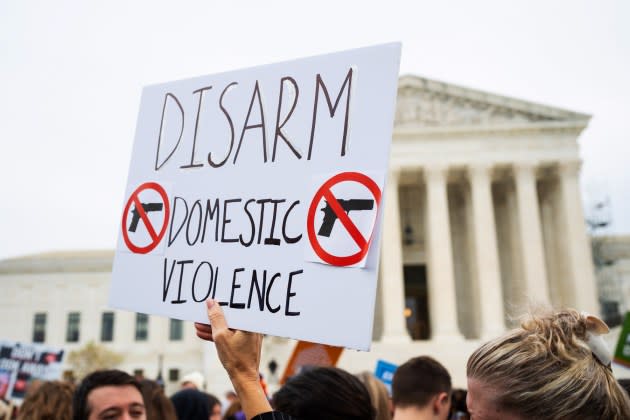The Supreme Court Is Still Poised to Torch Gun Safety Laws

We dodged a bullet with the Supreme Court this term. Literally.
Last year, the Fifth Circuit Court of Appeals decided that domestic abusers subject to qualifying protective orders must be allowed to purchase and carry firearms. You read that right. In U.S. v. Rahimi, the court ruled that the Constitution requires that abusers who have already been deemed a threat be permitted to buy and carry a gun if they so choose. The Supreme Court reversed that dangerous decision last week and ruled that the government can, in fact, prohibit abusers from carrying guns, just as it has done for decades. That’s a relief.
But the fact that Rahimi even made it this far is a failure. There never should have been a question as to whether the government could validly prevent domestic violence abusers from possessing firearms while under a protective order. When abusers are armed, they’re five times more likely to kill their victims, and for that reason, these laws have been on the books for decades. It was the Supreme Court’s erroneous, nonsensical, and flat-out dangerous decision last year in New York State Rifle & Pistol Association, Inc. v. Bruen caused this farce — and continues to threaten gun laws that are the bedrock of public safety.
Using an absurd reading of “originalism,” the Court in Bruen undid over a century of precedent and rewrote the constitutional test under which the 2nd Amendment must now be read by the courts. A favorite of conservative jurists, originalism dictates that for a law to be constitutional, it must comport with a literal reading of the Constitution as it was understood 250 years ago, when the Constitution was written. But the Supreme Court’s decision in Bruen stretches that standard to its logical extreme to say that for a gun law to be constitutional, there must be a similar such law on the books in the historical record. This is a dangerous legal standard, and one ripe for abuse. Rahimi shows us why.
In a ruling littered with logical inconsistencies, cherry-picked facts, and historical inaccuracies, the Fifth Circuit used the Bruen test to rule that Zackey Rahimi, a man who was involved in multiple shootings after being placed under a domestic violence protective order for alleged assault against his ex-girlfriend, should be allowed to carry a gun because there was no founding-era law that prohibited abusers from owning firearms. This gets at the fundamental flaw in Bruen, and the danger to us all. The Fifth Circuit is right in that there was no identical law at our nation’s founding, because domestic violence was not outlawed and women had few rights or protections. In fact, beating your wife was legal in many states until far into the 20th Century. Marital rape was only outlawed throughout the entire United States in 1945. But even though domestic abuse is abhorrent and repugnant to us as a society now, Bruen does not care for such niceties. It cares only about whether or not the laws of today parallel the laws of an era when white men could own slaves and it was legal to beat women.
The Second Amendment is practically the only constitutional right subject to this absurd reading of the law, where courts must weigh the assault rifles of today against the muskets of the past. Life today is vastly different than it was 200 years ago, and so are our laws. In the intervening years, Black men obtained the right to vote (1870), as did white women (1920), Asian Americans (1952), and Native Americans (1957). Even so, often insurmountable barriers existed to voting — especially for Black people — until the 1965 Voting Rights Act. Further, our gun violence epidemic and incredibly high death rate did not exist 200 years ago. Over 40,000 Americans are dying from gun violence every year. That would have been unheard of in 1791, when guns held only one round at a time.
To subject an imperfect but vastly more equal modern world today to the laws of a world where slavery was legal, people had no electricity and penicillin hadn’t yet been invented is an absolute farce. And as Rahimi demonstrates, this test threatens to puncture vast holes in the already fragile system of gun safety. While the court undid this profound failure in Rahimi to once again protect victims of domestic abuse, and loosened the Bruen test slightly, Bruen stands largely intact and its dangerous logic looms large. Numerous other gun safety laws — critical tools to keep already sky-high gun death rates from shooting even higher — are at risk. Litigious gun advocacy groups are using Bruen as a basis to challenge common-sense gun safety laws across the country, from assault weapons bans, ghost gun regulations, minimum age requirements, and even laws that keep firearms out of sensitive spaces such as schools, parks, and libraries.
The Supreme Court has much more work to do, we hope, to clarify its logic in Bruen and undo some of the most harmful pieces of that decision. Because as long as Bruen stands as is, gun safety laws in America remain on unsteady ground, and what few tools we do have to protect our communities and our children from gun violence will remain threatened. As long as gun violence runs rampant, blood will be on the Supreme Court’s hands.
Ciara Malone is the legal director at March For Our Lives.
More from Rolling Stone
Trump Leverages Supreme Court Immunity Decision in Bid to Overturn Criminal Conviction
'It's Like Christmas': Team Trump Stunned by Massive Supreme Court Immunity Win
Best of Rolling Stone

